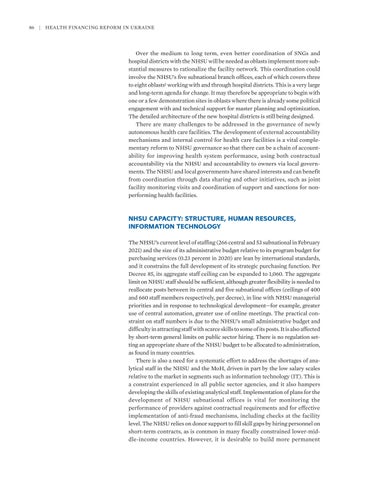86
| Health Financing Reform in Ukraine
Over the medium to long term, even better coordination of SNGs and hospital districts with the NHSU will be needed as oblasts implement more substantial measures to rationalize the facility network. This coordination could involve the NHSU’s five subnational branch offices, each of which covers three to eight oblasts1 working with and through hospital districts. This is a very large and long-term agenda for change. It may therefore be appropriate to begin with one or a few demonstration sites in oblasts where there is already some political engagement with and technical support for master planning and optimization. The detailed architecture of the new hospital districts is still being designed. There are many challenges to be addressed in the governance of newly autonomous health care facilities. The development of external accountability mechanisms and internal control for health care facilities is a vital complementary reform to NHSU governance so that there can be a chain of accountability for improving health system performance, using both contractual accountability via the NHSU and accountability to owners via local governments. The NHSU and local governments have shared interests and can benefit from coordination through data sharing and other initiatives, such as joint facility monitoring visits and coordination of support and sanctions for nonperforming health facilities.
NHSU CAPACITY: STRUCTURE, HUMAN RESOURCES, INFORMATION TECHNOLOGY The NHSU’s current level of staffing (266 central and 53 subnational in February 2021) and the size of its administrative budget relative to its program budget for purchasing services (0.23 percent in 2020) are lean by international standards, and it constrains the full development of its strategic purchasing function. Per Decree 85, its aggregate staff ceiling can be expanded to 1,060. The aggregate limit on NHSU staff should be sufficient, although greater flexibility is needed to reallocate posts between its central and five subnational offices (ceilings of 400 and 660 staff members respectively, per decree), in line with NHSU managerial priorities and in response to technological development—for example, greater use of central automation, greater use of online meetings. The practical constraint on staff numbers is due to the NHSU’s small administrative budget and difficulty in attracting staff with scarce skills to some of its posts. It is also affected by short-term general limits on public sector hiring. There is no regulation setting an appropriate share of the NHSU budget to be allocated to administration, as found in many countries. There is also a need for a systematic effort to address the shortages of analytical staff in the NHSU and the MoH, driven in part by the low salary scales relative to the market in segments such as information technology (IT). This is a constraint experienced in all public sector agencies, and it also hampers developing the skills of existing analytical staff. Implementation of plans for the development of NHSU subnational offices is vital for monitoring the performance of providers against contractual requirements and for effective implementation of anti-fraud mechanisms, including checks at the facility level. The NHSU relies on donor support to fill skill gaps by hiring personnel on short-term contracts, as is common in many fiscally constrained lower-middle-income countries. However, it is desirable to build more permanent

